
Global Importance of Arboviruse, Sandfly Fever (Pappataci Fevre, Three-Days fever, Phlebotomus Fever)
*Corresponding Author(s):
Hassan VatandoostDepartment Of Medical Entomology And Vector Control, School Of Public Health, Tehran University Of Medical Sciences, Tehran, Iran
Email:hvatandoost1@yahoo.com / vatando@tums.ac.ir
Abstract
- Objectives: Sandflies are vectors of different types of Leishmaniasis (Protozoa),Sandfly fever (virus) and Bartenollosis (Carrion’s disease) (Bacteria). Sandfly fever (Pappataci fevre, Three-days fever, Phlebotomus Fever) is one of the arbovirus disease which can be transmitted via sand fly bite and transmission. Many serotypes of virus as sand fly fever have been reported so far.
- Methods: To provide authentic information about this novel, the reliable data on academic resources such as Google Scholar, Scopus, Web of Science, Springer, Pro-Quest, Wiley Online, Science Direct, Research Gate, PubMed, Sage, and SID were used.
- Results: The arboviruse, Sandfly fever disease is transmitted by the bites of phlebotomine sandflies of the Genus Phlebotomus, in particular, Phlebotomus papatasi, P. perniciosus, P. perfiliewi. Sand fly fever virus can be classified as a bunyaviridae family. It occurs in parts of Europe, Asia, Africa, and Latin America. The symptoms of diseases is feeling of lassitude, abdominal distress, and dizziness, followed within one day by a chilly sensation and a rapid rise in temperature.
- Discussion: The diseases is more well-known among immigrants and military personnel from non-endemic regions. There is no specific treatment for the diseases. The main important measure is vector control using different insecticide recommended by Wordl Health Organization as residual spraying and impregnated bednets. There are several reports of insecticide resistance in the vectors wordlwide. Monitoring and mapping of insecticide resistance is important for decision making.
Keywords
Arboviruse; Contro; Epidemiology; Sandfly fever
Review
Sandflies belong to Order Diptera, Sub-order Nematocera, Family Psychodidae, Genus: Phlebotomus, Lutzomyia, Sergentomyia, Bruptomyia, Warileya, Chinius. Thera er around 600 species worldwide. Phlebotomus (old world), Lutzomyia (new world) are the main vectors. Eggs are ovoid, (0. 3-0. 4mm), 15-100 eggs in each oviposition,Laying eggs in cracks and holes in inorganic materials with high humidity,Egg hatch after 6-12 days. An egg of phelebotomine sandfly with mosaic pattern on the shell. Larvae have 4 instar . 4-6 mm long, black head,abdominal segments have pseudopods,matchsticks hair on the segments,end of the abdomen 2 pairs pf caudal bristles. Larval development ocured in 21-60 days depend on species, temperature and food. Diapuse occurs in winter at the larval stage. They are scavenger, feed on organic matter, fungi, decaying leaves, semi-rotting vegetation, animal faeces, decomposing bodies of arthropods. Pupal stage is 7-14 days. Larval skin can bee seen at the end of pupae. External morphology of Adult is 2-3mm in length, hairy appearance, large black eyes, long legs, long antennae, mouthparts in female for bloodsucking, maxillary palps segmented, wing are held erected, abdomen in females is round, abdomen in male pair of claspers. The whole life cycle is 30-100 days. Phlebotomus feed on man and animals. Sergentomyia feed on reptile and rarely on man. Lutzomyia feed on mammals and man. Most species are exophagic. Few species are endophilic. They have hopping type of flight. They are nocturnal. Only female suck blood on man, domestic animals, dogs, urban and wild rodents, snakes, lizard, amphibians, birds. Adult resting sites are: sheltered dark and humid sites,tree trunks and holes, foliages of the holes, animal burrows, termite burrows, caves, rocks fissure, cracks in the ground,inside human and animal habitations (Figures 1-3) [1-8].
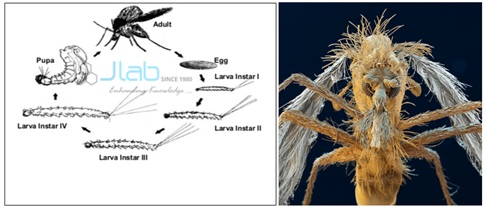 Figure 1: Life cycle of sandfly.
Figure 1: Life cycle of sandfly.
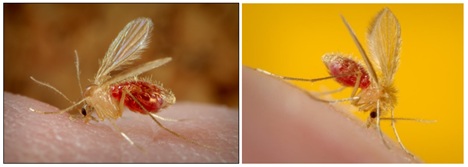 Figure 2: Adult female of sandfly takig blood from hosts.
Figure 2: Adult female of sandfly takig blood from hosts.
 Figure 3: Sandfly bites on human.
Figure 3: Sandfly bites on human.
Medical Importance Of Sandflies
Nuisance, biting cause irritation. They are vectors of different types of : Leishmaniasis (Protozoa),Sandfly fever (virus) and Bartenollosis (Carrion’s disease) (Bacteria). Phlebotominae of sandflies is a vector of leishmaniasis, a disease that spreads to more than 98 countries worldwide. Cutaneous Leishmaniasis (CL), Mucocutaneous Leishmaniasis (MCL), and Visceral Leishmaniasis (VL) or "kala-azar" are the three main clinical forms of the disease (Figure 4) . Leishmaniasis is more common in tropical and temperate regions where sandflies are more common. There are an estimated 1. 3 million new casesof leishmaniasis and 20 000 to 30 000 deaths from it every year (Figure 5). Depending on the type of leishmaniasis, the disease can cause fever, weight loss, enlargement of the spleen and liver, anaemia, rash and skin ulcers. Both cutaneous and mucocutaneous leishmaniasis can lead to disfiguring scars and associated stigma. The disease affects mainly the poorest people in the community, and is associated with population displacement, poor housing and lack of resources. During the past 20 years, the disease has spread considerably due to migration and environmental changes such as deforestation, building of dams, irrigation schemes, urbanization and population displacement due to conflicts and war. Malnutrition, poor living conditions and sleeping outside or on the ground increase the risk of becoming infected. Poverty can also increase the progression of the disease, worsening illness and leading to death, mainly through poor nutrition and weak immunity.
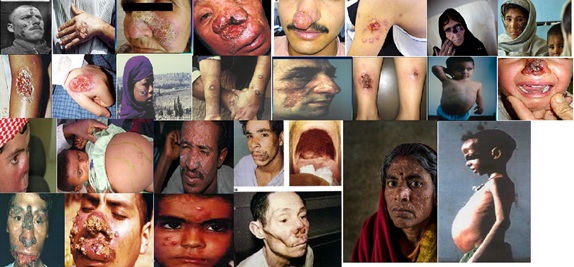 Figure 4: Different types of leishmaniasis in the world.
Figure 4: Different types of leishmaniasis in the world.
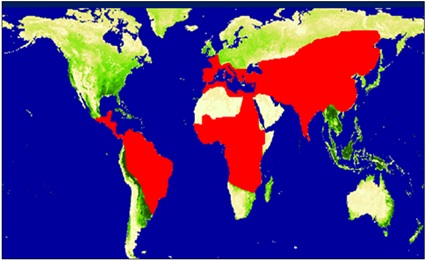 Figure 5: Global map of Leishmaniasis.
Figure 5: Global map of Leishmaniasis.
Sandfly Fever
Sand fly fever that is also called three day fever, papatasi fever and phlebotomous fever is one of the arbovirus disease which can be transmitted via sand fly bite and transmission of virus within phlebotomus species transovarial. The name, pappataci fever, comes from the Italian word for sand fly, it is the union of the word. pappa (food) ,taci (silent) which distinguish these insect from mosquitoes which produce a typical noise while flying. The native population seems to be immune, probably because of infection in childhood. Newcomers, however, usually succumb to the disease during the first epidemic. Besides this «horizontal» virus transmission from man to sandfly, the virus can be transmitted in insects transovarially, from an infected female sand fly to its offspring. Pappataci fever is seldom recognised in endemic populations because it is mixed with other febrile illnesses of childhood, but it is more well-known among immigrants and military personnel from non-endemic regions. Sandfly fever is a disease of considerable military importance because, although it is never fatal and has no serious sequelae, it may nevertheless suddenly incapacitate large numbers of men. The disease was first recognized among American soldiers when the morbidity rate of febrile cases increased during the period they spent in North Africa (end of April 1943). During an outbreak of the disease in Naples county, Italy. Sicilian virus was isolated from Italian soldiers during world war II. It has to be said that, many rodents could be acted as a reservoir of the disease. Little is known about sand fly fever with manifestations such as severe fever, headache and photophobia at the frontiers before the imposed war Iraq against Iran (1980-1988). Sero epidemiological studies were carried out on affected soldiers by using Complement Fixation (CF) and Hemmglutination Inhibition (HI) tests [9-21].
Vectros
Adults are about 1. 5-3. 0mm long and yellowish in colour, with conspicuous black eyes, and hairy bodies, wings, and legs. The oval lanceolate wings are carried erect on the humped thorax. These small insects bite during the night and early morning hours and are found near ground level. Higher levels and strong breezes, and have a very short They avoid range of flight. It is thought that they seldom move more than fifty yards from their breeding places.
Etiology
The disease is transmitted by the bites of phlebotomine sandflies of the Genus Phlebotomus, in particular, Phlebotomus papatasi, P. perniciosus, P. perfiliewi. Sand fly fever virus can be classified as a bunyaviridae family viruses (Figure 6). Many serotypes of virus as sand fly fever have been reported so far, but, Sicilian and Naples are the most prevalent cases in many infected countries amongst the other serotypes Naple virus was found by Sabin and Paul in 1924.
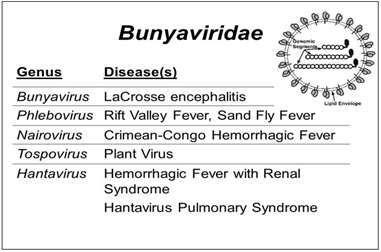 Figure 6: Bunyaviridae virus , the agent of sandfly fever.
Figure 6: Bunyaviridae virus , the agent of sandfly fever.
Epidemiology
Pappataci fever is prevalent in the easern hemiphere between 20°N and 45°N. Southern Europe, North Africa, Balkans, Eastern Mediterranean , Iraq, Iran,Pakistan, Afghanistan, India.
Risk Factors
Risk factors for Sandfly fever are factors that do not seem to be a direct cause of the disease, but seem to be associated in some way. Having a risk factor for Sandfly fever makes the chances of getting a condition higher but does not always lead to Sandfly fever. Also, the absence of any risk factors or having a protective factor does not necessarily guard you against getting Sandfly fever.
Sources of Infection
In the western hemisphere proliferation of sandflies in the around of residential human, especially the collection of old car tires, Slot stone buildings and under rocks. They breed in rubble, cracks in walls, dugouts, and similar areas.
Transmission
Sand fly fever is a viral disease transmitted by the bite of an infective sand fly and occurs in parts of Europe, Asia, Africa, and Latin America. In nature the disease is transmitted by the bite of the female of a small midge Phlebotomus papatasi. It occurs primarily in tropical and subtropical areas with hot, dry weather.
Transmission of Sand Fly Fever from Person to Person
Sandfly fever is considered infectious but is not transmitted from person to person. Generally, a disease like this is caused by an infectious agent and not spread between people. Sandfly fever, although infectious, is not a genetic disease. It is not caused by a defective or abnormal gene.
Sign and Symptom
In human hosts, the virus multiplies and becomes widely disseminated throughout the body. Within two and one-half to five days after exposure, there is suddenly a feeling of lassitude, abdominal distress, and dizziness, followed within one day by a chilly sensation and a rapid rise in temperature . These symptoms may be severe but are rarely, if ever, fatal symptoms appear 3 to 6 days after the sand fly bite. It is characterized by high grade fever, headache, and myalgia. TOS infection can result in aseptic meningitis and meningo encephalitis. Blood examination usually showed a leucopenia with a shift to the left of the neutrophils. The symptoms are: fever, headache, chills, weakness, flu-like symptoms, myalgia, joint pains, flushing, bloodshot eyes, nausea.
Natural Reservoir
Phlebotomine sandflies (Psychodidae) are the natural reservoir and transmit to humans via bite. Psychodidae has a wide geographical distribution.
Sandfly Fever Serocomplex
The sand fly serocomplex is divided into two groups: Naples and Sicilian. Sandfly fever Naples group: Granada virus, Massila virus, Punique virus Sandfly fever Naples virus, Toscana virus
Sand Fly Fever Sicilian Group
Belterra virus, Chagres virus, Corfu virus, Rift Valley fever virus, Sandfly fever Cyprus virus, Sandfly fever Sicilian virus, Sandfly fever Turkey virus.
Incubation & Contagious Period
Incubation period is up to 6 days, usually between 3 to 4 days and rarely less.
- Contagious Period: Sandflies in about 7 days after feeding from an infected person can transmit the virus for lifetime and that about a month to keep this infection. The sandfly becomes infected when biting an infected human in the period between 48 hours before the onset of fever and 24 hours after the end of the fever, and remains infected for its lifetime.
- Distribution of Pappataci Fever by Serotype: T, Toscana, S, Sicilian; N, Naples (Figure 7).
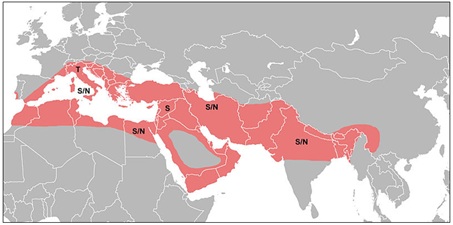 Figure 7: Global map of sandfly fever.
Figure 7: Global map of sandfly fever.
Genetics of Sandfly Fever
Sandfly fever is not a genetic disease. Sandfly fever is an infectious disease. Some infectious diseases can be contagious between people while others are acquired from the person's surroundings but are not spread from one person to another.
Diagnosis
Sandfly fever is due to a small virus which is present in blood of a patient from twenty-four hours before till twenty-four the hours after the onset of the disease. The virus can be readily transferred to volunteers by intravenous or intracutaneous injection. It has not so far been transmitted to lower animals.
Treatments to Consider for Sandfly Fever
May include bed rest, pain medications(analgesics), fluids, more treatment, no immunization.
Sand fly fever entity graft is shown in figure 8.
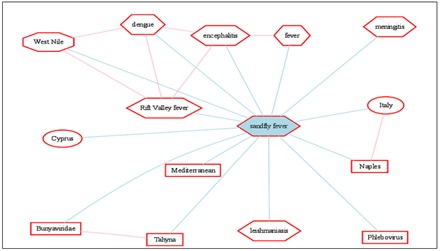 Figure 8: Sand fly fever entity graft.
Figure 8: Sand fly fever entity graft.
Prevention of Sandfly Fever
Prevention of sand fly bites, and control of sand flies and their breeding grounds with insecticides are the principal methods for prevention. Mosquito nets may not be sufficient to prevent sand fly bites (10 to 12 holes in square centimeters and the diameter of the hole is not more than 0/085cm). Methods of prevention of Sandfly fever mentioned in various sources. None of these methods guarantee prevention of Sandfly fever. Avoid sand fly bites, clothing and insect repellents [22-29].
Ethics Approval and Consent to Participate
Not applicable.
Consent for Publication
Not applicable.
Availability of Data and Materials
Applicable.
Competing Interests
The authors declare that they have no competing interests.
Funding
No funding.
Authors' Contributions
All authors were involved.
References
- Dhiman RC, Yadav RS (2016) Insecticide resistance in phlebotomine sandflies in Southeast Asia with emphasis on the Indian subcontinent. Infect Dis Poverty 5: 1-10.
- Pathirage DR (2020) Insecticide susceptibility of the sand fly leishmaniasis vector Phlebotomus argentipes in Sri Lanka. Parasit Vector 13: 1-12.
- Chowdhury R, Das ML, Chowdhury V, Roy L, Faria S, et al. (2018) Susceptibility of field-collected Phlebotomus argentipes (Diptera: Psychodidae) sand flies from Bangladesh and Nepal to different insecticides. Parasites Vectors 11: 1-11.
- Denlinger DS (2015) Assessing insecticide susceptibility of laboratory Lutzomyia longipalpis and Phlebotomus papatasi sand flies (Diptera: Psychodidae: Phlebotominae). J Med Entomol 52: 1003-1012.
- Pessoa GCD, Lopes JV, Rocha MF, Pinheiro LC, Rosa ACL, et al. (2015) Baseline susceptibility to alpha-cypermethrin in Lutzomyia longipalpis (Lutz & Neiva, 1912) from Lapinha Cave (Brazil). Parasites Vectors 8: 1-6.
- Alexander B, Barros VC, Souza SFD, Barros SS, Teodoro LP, et al. (2009) Susceptibility to chemical insecticides of two Brazilian populations of the visceral leishmaniasis vector Lutzomyia longipalpis (Diptera: Psychodidae). Trop Med Inter Health 14: 1272-1277.
- Rama A, Kesari S, Sushmita D, Kumar D (2017) Studying DDT susceptibility at discriminating time interval focusing maximum limit of exposure time survived by DDT resistant Phlebotomus argentipes (Diptera: Psychodidae): An investigatory report. Jpn J Infect Dis 70: 437-441.
- Sardar AA (2018) Insecticide susceptibility status of Phlebotomus argentipes and polymorphisms in voltage-gated sodium channel (vgsc) gene in Kala-azar endemic areas of West Bengal, India. Acta Trop 185: 285-293.
- Aghaei AA, Rassi Y, Sharifi I, Abai MR, Oshaghi MA, et al. (2011) Susceptibility status of Phlebotomus papatasi and sergenti (Diptera: Psychodidae) to DDT and Deltamethrin in a focus of cutaneous leishmaniasis after earthquake Strike in Bam, Iran. Iran J Arthropod-Borne Dis 5: 32-41
- Brett DM, Claborn DM (2019) Sand fly fever: What have we learned in one hundred years? Military Med 174: 426-431.
- Coleman RE, Burkett DA, Sherwood V, Caci J, Spradling S, et al. (2007) Impact of phlebotomine ,sand flies on U.S. military operations at Tallil Air Base, Iraq: 2. Temporal and geographic distribution of sand flies. Med Entomol 44: 29-41.
- Ellis SB, Appenzeller G, Lee H, Mullen K, Swenness R, et al. (2008) Outbreak of sand fly fever in Central Iraq, September 2007. Military Med 173: 949-953.
- Guler S, Guler E, Caglayic DY, Kokoglu OF, Ucmak H, et al. (2012) A sandfly fever virus outbreak in the East Mediterranean region of Turkey. Inter J Infect Dis 16: 244-246.
- Hyeman H, Davids L (2008) Control of communicable disease manual. An official report of the American Public Health Association.
- Tavana AM (2001) The seroepidemiological studies of sand fly fever in Iran during imposed war. Iran J Publ Health 30: 145-146.
- Papa A, Konstantinou G, Pavlidou V, Antoniadis A (2006) Sandfly fever virus outbreak in Cyprus. Clin Microbiol Infect 12: 192-195.
- Pauli C, Schwarz TF, Meyer CG, Jäger G (2015) Neurological symptoms after an infection by the sandfly fever virus. Dtsch Med Wochenschr 120: 1468-1472.
- Schultze D, Korte W, Rafeiner P, Niedrig M (2012) First report of sandfly fever virus infection imported from Malta into Switzerland, October 2011. Euro Surveill 17: 20209.
- World Health Organization (2015) Collaboration center for remote sensing and geographic information system of public healths.
- Pener H, Wilamovsky A (1987) Base-line susceptibility of Phlebotomus papatasi to insecticides. Med Vet Entomol 1: 147-149.
- Denlinger DS (2017) Understanding the mechanisms of insecticide resistance in Phlebotomus papatasi and Lutzomyia longipalpis sand flies (Diptera: Psychodidae: Phlebotominae): Utah State University.
- Shirani-Bidabadi L, Zahraei-Ramazani A, Yaghoobi-Ershadi MR, Rassi Y, Akhavan AA, et al. (2017) Assessing the insecticide susceptibility status of field population of Phlebotomus papatasi (Diptera: Psychodidae) in a hyperendemic area of zoonotic cutaneous leishmaniasis in Esfahan Province, Central Iran. Acta Trop 176: 316-322.
- Saeidi Z, Vatandoost H, Akhavan A, Yaghoobi-Ershadi M, Rassi Y, et al. (2013) Baseline insecticide susceptibility data of Phlebotomus papatasi in Iran. J Vector borne Dis 50: 57-65.
- Shirani-Bidabadi L, Zahraei-Ramazani AR, Yaghoobi-Ershadi MR, Akhavan AA, Oshaghi MA, et al. (2020) Monitoring of laboratory reared of Phlebotomus papatasi (Diptera: Psychodidae), main vector of zoonotic cutaneous leishmaniasis to different imagicides in hyper endemic areas, Esfahan province, Iran. J Arthropod-borne Dis 14: 116-126.
- Rassi Y, Asadollahi H, Abai MR, Kayedi MH, Vatandoost H (2021) Efficiency of two capture methods providing live sand flies and assessment the susceptibility status of Phlebotomus papatasi (Diptera: Psychodidae) in the foci of cutaneous leishmaniasis, Lorestan Province, Western Iran. J Arthropod Borne Dis 14: 408-415.
- Afshar AA, Rassi Y, Sharifi I, Abai M, Oshaghi M, et al. (2011) Susceptibility status of Phlebotomus papatasi and sergenti (Diptera: Psychodidae) to DDT and deltamethrin in a focus of cutaneous leishmaniasis after earthquake strike in Bam, Iran. Iran J Arthropod-borne Dis 5: 32-40.
- Rassi Y, Jalali M, Vatandoost H (2000) Susceptibility status of Phlebotomus papatasi to DDT in Arsanjan country in Fars province, Iran. Iran J Public Health : 21-26.
- Saeidi Z, Vatandoost H, Akhavan AA, Yaghoobi - Ershadi MR, Rassi Y, et al. (2012) Baseline susceptibility of a wild strain of Phlebotomus papatasi (Diptera: Psychodidae) to DDT and pyrethroids in an endemic focus of zoonotic cutaneous leishmaniasis in Iran. Pest Manag Sci 68: 669-675.
- World Health Organization (2014) A global brief on vector-borne diseases. World Health Organization, Geneva, Switzerland.
Citation: Vatandoost H (2023) Global Importance of Arboviruse, Sandfly Fever (Pappataci Fevre, Three-Days fever, Phlebotomus Fever). J Toxicol Cur Res 7: 024.
Copyright: © 2023 Hassan Vatandoost, et al. This is an open-access article distributed under the terms of the Creative Commons Attribution License, which permits unrestricted use, distribution, and reproduction in any medium, provided the original author and source are credited.

